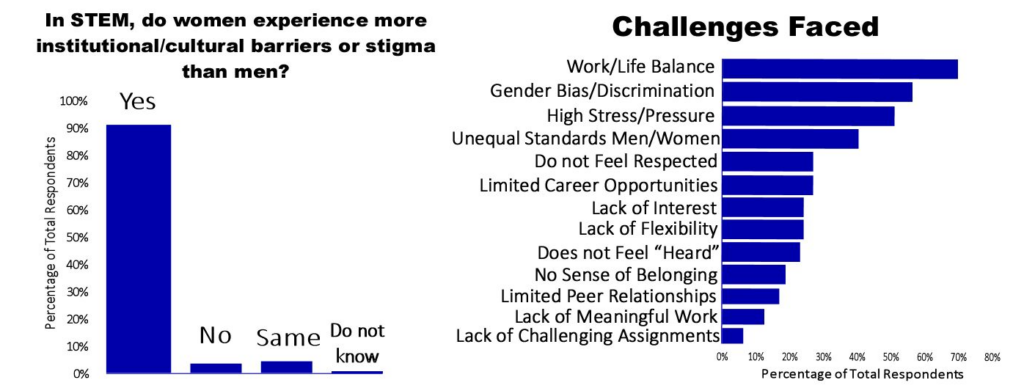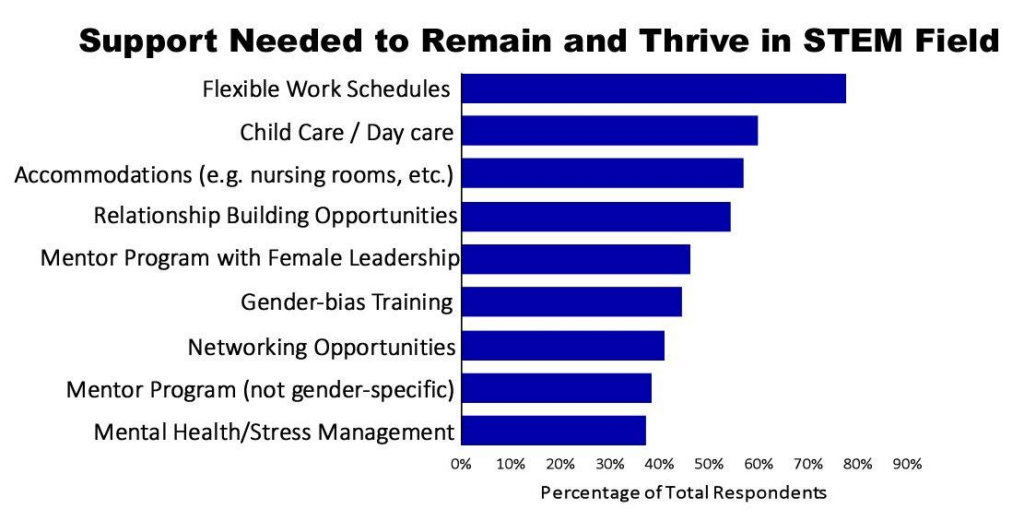“Companies need qualified talent more than ever, and I believe fostering young women’s interest in STEM is non-negotiable for organizations that wish to thrive in today’s landscape.”
(Chris Moore is CEO of FIRST, a global community preparing young people 4-18 for the future through inclusive, team-based robotics programs1)
The analysis “Factors Contributing to Women’s Underrepresentation in STEM Fields: An Analysis of Three Studies”2 explored how social and environmental factors lead to women’s under-representation in science and engineering. The analysis revealed that gender stereotypes and biases frequently deter girls and women from entering STEM fields, while cultural and institutional obstacles create unfriendly or unwelcoming professional settings. Leaders should evaluate their human resources practices to enhance workplace culture and ensure that recruiting processes, criteria, AI tools, and other resources are unbiased.
While companies bear much of the responsibility for talent pipelining, parents can also combat stereotypes at home to foster girls’ confidence in STEM from a young age. Parents, aware of conflicting messages from pop culture, can counteract these by encouraging their children to pursue their interests. If a daughter enjoys tinkering with LEGO bricks, parents should encourage her creativity; if she likes exploring the woods, they can take her on nature walks to discover new plant and animal species. Beyond professional efforts, many small actions can reinforce early interest in STEM.
Students often form their career aspirations based on media portrayals. Unfortunately, the lack of diversity, equity, and inclusion in these representations can limit their views of possible career paths. If female students don’t see women celebrated as astronauts, doctors, or other professionals, they might assume there’s no place for them in STEM, which is far from the truth.
The results of the study “Why is Retaining Women in STEM Careers so Challenging? A Closer Look at Women’s Insights and Experiences in STEM Fields”3 offer valuable insights into how employers and academia can better support women in STEM, improve retention, and narrow the gender gap. Key practices include enhancing workplace flexibility, work-life balance, and support for childcare responsibilities. Comparing the experiences of women in engineering versus science highlights the need for engineering employers to offer more networking opportunities, mentorship programs, gender-bias and diversity training, and meaningful work experiences to attract and retain women in engineering careers.

Fig. 1. Workplace challenges faced by Women in STEM3
Fig. 2. Support systems identified by women in STEM fields as being necessary for retention3
Look beyond the figures4:
44% – of Europeans think that the most important role of a woman is to take care of her home and family.
36% – is how much less women overall earn on average compared to men.
8% – of CEOs in large-listed companies in the EU are women.
You can find more about breaking gender stereotypes from the sites of:
- https://end-gender-stereotypes.campaign.europa.eu/: #EndGenderStereotypes4
- inclusionhub.com: Breaking Gender Stereotypes: Encouraging Participation in Non-Traditional Roles5
- https://www.betterhelp.com/advice/stereotypes/: 22 Ways To Overcome Gender Stereotypes6
Bibliography:
- https://www.forbes.com/sites/forbesbusinesscouncil/2024/03/27/young-women-in-stem-how-businesses-can-help-close-the-gender-gap/
- https://womencourage.acm.org/2023/wp-content/uploads/2023/06/womencourage2023-posters-paper81.pdf
- https://www.researchgate.net/figure/Workplace-challenges-faced-by-Women-in-STEM_fig2_352227073
- https://end-gender-stereotypes.campaign.europa.eu/index_en
- https://www.inclusionhub.com/articles/breaking-gender-stereotypes-encouraging-participation-in-non-traditional-roles
- https://www.betterhelp.com/advice/stereotypes/22-ways-to-overcome-gender-stereotypes/

 Български
Български Ελληνικά
Ελληνικά Polski
Polski Português
Português Română
Română
